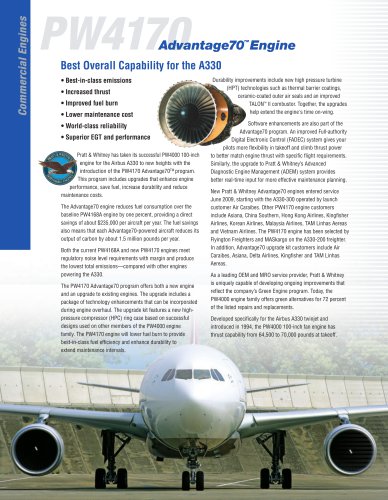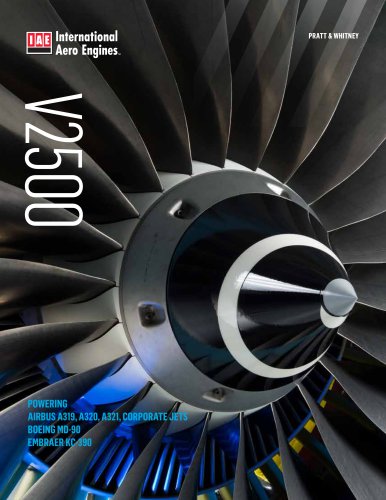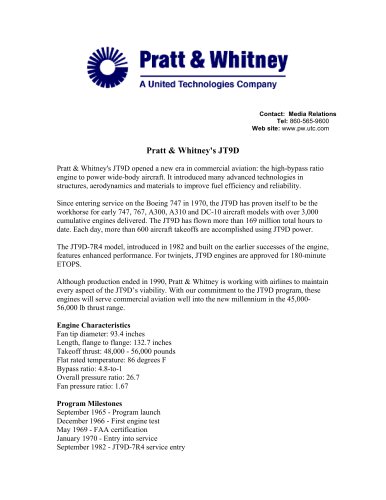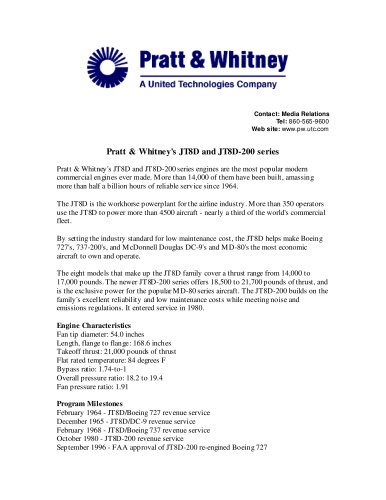
Catalog excerpts

F135 Engine FAST FACTS PROGRAM HIGHLIGHTS Pratt & Whitney designs and builds the most advanced military fighter engines in the world. These engines provide reliable and affordable power for cutting-edge aircraft, such as the F-15 Eagle, F-16 Fighting Falcon, F-22 Raptor, and F-35 Lightning II. • ratt & Whitney’s F135 propulsion system powers the F-35 Lightning II, the fifth generation, advanced, single-engine tactical P fighter developed by Lockheed Martin in conjunction with BAE Systems and Northrop Grumman. • he F135 provides a maximum thrust of 43,000 lbs. for three F-35 variants: the F-35A for conventional takeoff and landing T (CTOL); the F-35B for short takeoff and vertical landing (STOVL); and the F-35C for aircraft carrier takeoff and landing (CV). F-35 Noise Levels are Comparable to Other High Performance Combat Aircraft • ll jets make noise. There are no noise threshold requirements specified for the F-35 aircraft or the F135 propulsion system. A However, tremendous advances in engine design provide far more capability for this fifth generation engine while mitigating noise to levels comparable to previously fielded fighter engines. • ircraft noise emissions are measured by the sound intensity, which is reflected in decibels (dB) on a sound level meter. A For the F-35 this is measured on the ground and in the air. Noise produced by an F-35 will vary based on power settings and the type of flight operations. In the air — When flying straight and level flight using Mil Power (the highest engine power setting — 100% engine thrust request — without using the afterburners), the noise from the F-35 is within 1-3 decibels of other high performance fighter aircraft such as the F-18C/D, F-18 E/F, and F-22 on the ground directly under the aircraft with the aircraft at 1000 feet above ground level. On the ground — When standing ~50 feet away from the engine, the noise is comparable (within 1-3 decibels) to other high performance fighter aircraft, such as the F-22 Raptor and the FA-18 E/F Super Hornet. • he F-35 can take off safely in all conditions (including with full fuel and weapons stores) at Mil Power without the need T for afterburner. • he F-35 program collected aircraft ground run-up and flyover noise data which was provided to U.S. services, international T partners, and foreign military sales customers to use to assess the environmental impact at F-35 bases. The most recent noise data analysis in 2013 generally corroborated the
Open the catalog to page 1
• F-35 engine noise is comparable to most previously fielded fighter aircraft. • During takeoff, the F-35A (111 dB) is essentially equal in noise level to the F-16 with the latest generation PW-229 engine (110 dB), and was measured at least 10 dB lower on two of three low altitude flight conditions. • Although the F-35A is generally louder for all conditions when compared to the F-16 with the earlier F100-PW-220 engine, the capability it delivers is a generation ahead (e.g., the F135 delivers more than twice the thrust capability of the F100-PW-220). • The F-35B is quieter than the legacy...
Open the catalog to page 2All PRATT & WHITNEY catalogs and technical brochures
-
PW4000-100 ENGINE (2025)
2 Pages
-
V2500 (2025)
2 Pages
-
PW800
6 Pages
Archived catalogs
-
PW1400G-JM
2 Pages
-
PW1100G-JM
2 Pages
-
2018 PW1200G
2 Pages
-
PW1900/PW1700G
2 Pages
-
PW1100G-JM Engine
2 Pages
-
PW1200G Engine
2 Pages
-
PW1400G-JM Engine
2 Pages
-
PW1700G & PW1900G Engine
2 Pages
-
PurePower PW1500G Engine
2 Pages
-
GP7200
2 Pages
-
F-35C
2 Pages
-
F135
2 Pages
-
PW100SMART
2 Pages
-
PW1200G
9 Pages
-
ce_v2500_fact
2 Pages
-
ce_pw4000_94_fact
2 Pages
-
ce_purepower_broch
8 Pages
-
ce_gp7200_fact
2 Pages


























